The Health Education Assets Library (HEAL) is a collection of over 22,000 freely available digital materials for health sciences education. The collection is now housed at the University of Utah J. Willard Marriott Digital Library.
TO
Filters: Collection: "ehsl_heal"
| Title | Description | Subject | Collection | ||
|---|---|---|---|---|---|
| 201 |
 |
Tooth ('free' gingiva of decalcified tooth, human, adult) | Stain: Hematoxylin and eosin. On top the gingival sulcus; at the left stratified junctional epithelium normally attached to the surface of the enamel (dissolved due to decalcification). Below the epithelium a focus of chronic inflammatory cell infiltration, followed by a bundle of fibers of the per... | oral cavity; acellular cementum; junctional epithelium | Poja Histology Collection - Oral Cavity Subset |
| 202 |
 |
Tongue (macroscopy, dorsal side, human) | At the bottom (apex) of the picture the dorsal side is covered with numerous closed packed, small, conical filiform papillae. Interspersed among them are the larger fungiform papillae. Posteriorily the circumvallatae papillae are arranged in a V-shape row. Behind the V-row the area is covered with l... | oral cavity; papillae | Poja Histology Collection - Oral Cavity Subset |
| 203 |
 |
Tongue Papillae Scheme - tongue, human, adult | A. Scheme survey dorsal surface of tongue (human, adult). Magnification 35x. B. Scheme of filiform and fungiform papillae (tongue, human, adult). Magnification 35x. 1. foliate papillae (rudimentary in human); 2. circumvallate papillae; 3. foramen cecum; 4. palatine tonsils; 5. filiform ... | oral cavity; papillae | Poja Histology Collection - Oral Cavity Subset |
| 204 |
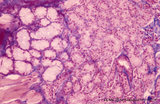 |
Tongue (lingual gland, human) | Stain: Azan. The posterior lingual gland is composed of areas with pure serous acini neighbouring pure mucous acini between the tongue muscles (at the left few striated fibers). | oral cavity; lingual gland | Poja Histology Collection - Oral Cavity Subset |
| 205 |
 |
Tongue (ventral part, human) | Stain: Hematoxylin and eosin. Non-keratinized squamous epithelium, followed by a small lamina propria and the intrinsic striated lingual muscles. | oral cavity; lingual muscles | Poja Histology Collection - Oral Cavity Subset |
| 206 |
 |
Villi of complete hydatidiform mole (human) | (A) Macroscopy aggregation (1) of abnormal villi of hydatidiform mole intermingled with blood clots (2). (B) After dissection of a complete mole grape-like aggregations of dilated chorionic villi are presented as numerous liquid-filled vesicles (1) varying in diameters (from few mm up to 1 cm) surr... | placenta; trophoblast; hydatiform mole | Poja Histology Collection - Placenta |
| 207 |
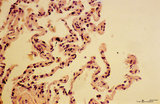 |
Trophoblast cell in lung alveolar interstitium (human, early midpregnancy) | Stain: Hematoxylin-eosin. It is well known that free circulating trophoblast cells can be found migrated into lung parenchyma during normal pregnancy. In this sample a large trophoblast cell (→) is localised within the normal alveolar interstitium. Alveolar phagocytes (*) are present in the alve... | placenta; trophoblast; lung | Poja Histology Collection - Placenta |
| 208 |
 |
Uvula (soft palate, human) | Stain: Azan. Detail of the uvula at the nasal side shows the border between the non-keratinized stratified squamous epithelium (right, oral side) and pseudostratified columnar epithelium (left, nasal side). The lamina propria is composed of dense connective tissue. At the bottom part of a blood-fil... | oral cavity; lining mucosa | Poja Histology Collection - Oral Cavity Subset |
| 209 |
 |
Uvula (soft palate, human; low magnification) | Stain: Azan. At the right (oral side, non-keratinized stratified squamous epithelium); at the left (nasal side, same epithelium). In the submucosa mainly mucous uvular glands are localized. At the bottom, striated muscle of the uvular muscle. The uvular tip is richly vascularized. | oral cavity | Poja Histology Collection - Oral Cavity Subset |
| 210 |
 |
Uvula (soft palate, human) | Stain: Azan. Detail of the uvula at the oral side; non-keratinized stratified squamous epithelium. Note richly vascularized lamina propria. In the submucosa mainly mucous uvular glands with draining ducts. | oral cavity; lining mucosa; mucous glands | Poja Histology Collection - Oral Cavity Subset |
| 211 |
 |
Vulva (Labeled) | External genitalia. Female. | Mons Pubis; Glans; External Urethral Orifice; Perineal Body; Opening of Vagina; Vestibule of Vagina; Labium Minus; Labium Majus | Royal College of Surgeons in Ireland Illustrations |
| 212 |
 |
Urinary System | Urinary system. Kidneys. Ureter. Bladder. | Common Iliac Veins; Common Iliac Arteries | Royal College of Surgeons in Ireland Illustrations |
| 213 |
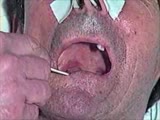 |
Cranial Nerve Exam: Abnormal Examples: Cranial Nerves 9 & 10 - Sensory & Motor: Gag Reflex | Using a tongue blade, the left side of the patient's palate is touched which results in a gag reflex with the left side of the palate elevating more then the right and the uvula deviating to the left consistent with a right CN 9 & 10 deficit. Video courtesy of Alejandro Stern, Stern Foundation. Neur... | Cranial Nerve Examination | NeuroLogic Exam: An Anatomical Approach |
| 214 |
 |
Cranial Nerve Exam: Abnormal Examples: Smooth Pursuit | The patient shown has progressive supranuclear palsy. As part of this disease there is disruption of fixation by square wave jerks and impairment of smooth pursuit movements. Saccadic eye movements are also impaired. Although not shown in this video, vertical saccadic eye movements are usually the i... | Cranial Nerve Examination | NeuroLogic Exam: An Anatomical Approach |
| 215 |
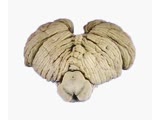 |
Coordination Exam: Anatomy: Subdivisions of the Cerebellum (includes Spanish audio & captions) | The cerebellum has 3 functional subdivisions, which function as feedback and feed forward systems. NeuroLogic Exam has been supported by a grant from the Slice of Life Development Fund at the University of Utah, the Department of Pediatrics and the Office of Education at the University of Nebraska M... | Coordination Examination | NeuroLogic Exam: An Anatomical Approach |
| 216 |
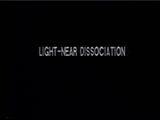 |
Cranial Nerve Exam: Abnormal Examples: Vergence | Light-near dissociation occurs when the pupils don't react to light but constrict with convergence as part of the near reflex. This is what happens in the Argyll-Robertson pupil (usually seen with neurosyphilis) where there is a pretectal lesion affecting the retinomesencephalic afferents controllin... | Cranial Nerve Examination | NeuroLogic Exam: An Anatomical Approach |
| 217 |
 |
Cranial Nerve Exam: Abnormal Examples: Cranial Nerves 9 & 10 - Sensory & Motor: Gag Reflex (x2) | Using a tongue blade, the left side of the patient's palate is touched which results in a gag reflex with the left side of the palate elevating more then the right and the uvula deviating to the left consistent with a right CN 9 & 10 deficit. Video courtesy of Alejandro Stern, Stern Foundation. Neur... | Cranial Nerve Examination | NeuroLogic Exam: An Anatomical Approach |
| 218 |
 |
Cranial Nerve Exam: Abnormal Examples: Smooth Pursuit (x2) | The patient shown has progressive supranuclear palsy. As part of this disease there is disruption of fixation by square wave jerks and impairment of smooth pursuit movements. Saccadic eye movements are also impaired. Although not shown in this video, vertical saccadic eye movements are usually the i... | Cranial Nerve Examination | NeuroLogic Exam: An Anatomical Approach |
| 219 |
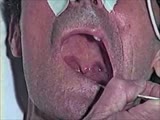 |
Cranial Nerve Exam: Abnormal Examples: Cranial Nerves 9 & 10 - Motor (x2) | When the patient says ah there is excessive nasal air escape. The palate elevates more on the left side and the uvula deviates toward the left side because the right side is weak. This patient has a deficit of the right 9th & 10th cranial nerves. Video courtesy of Alejandro Stern, Stern Foundation. ... | Cranial Nerve Examination | NeuroLogic Exam: An Anatomical Approach |
| 220 |
 |
Cranial Nerve Exam: Abnormal Examples: Cranial Nerves 9 & 10 - Motor | When the patient says ah there is excessive nasal air escape. The palate elevates more on the left side and the uvula deviates toward the left side because the right side is weak. This patient has a deficit of the right 9th & 10th cranial nerves. Video courtesy of Alejandro Stern, Stern Foundation. ... | Cranial Nerve Examination | NeuroLogic Exam: An Anatomical Approach |
| 221 |
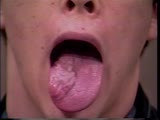 |
Cranial Nerve Exam: Abnormal Examples: Cranial Nerve 12 - Motor (x2) | Notice the atrophy and fasciculation of the right side of this patient's tongue. The tongue deviates to the right as well because of weakness of the right intrinsic tongue muscles. These findings are present because of a lesion of the right 12th cranial nerve. NeuroLogic Exam has been supported by a... | Cranial Nerve Examination | NeuroLogic Exam: An Anatomical Approach |
| 222 |
 |
Cranial Nerve Exam: Abnormal Examples: Cranial Nerve 12 - Motor | Notice the atrophy and fasciculation of the right side of this patient's tongue. The tongue deviates to the right as well because of weakness of the right intrinsic tongue muscles. These findings are present because of a lesion of the right 12th cranial nerve. NeuroLogic Exam has been supported by a... | Cranial Nerve Examination | NeuroLogic Exam: An Anatomical Approach |
| 223 |
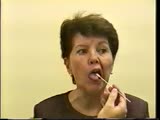 |
Cranial Nerve Exam: Abnormal Examples: Cranial Nerve 7 - Sensory, Taste | The patient has difficulty correctly identifying taste on the right side of the tongue indicating a lesion of the sensory limb of the 7th nerve. NeuroLogic Exam has been supported by a grant from the Slice of Life Development Fund at the University of Utah, the Department of Pediatrics and the Offic... | Cranial Nerve Examination | NeuroLogic Exam: An Anatomical Approach |
| 224 |
 |
Coordination Exam: Anatomy: Midline Ataxia (includes Spanish audio & captions) | Clinically, the ataxic syndromes caused by vestibulocerebellar and spinocerebellar disease are lumped together and are called midline or equilibratory (gait) ataxias. The hallmarks of these midline ataxic syndromes are truncal instability manifested by titubation (tremor of the trunk in an anterior-... | Coordination Examination; Anterior Lobe of Cerebellum; Flocculonodular Lobe | NeuroLogic Exam: An Anatomical Approach |
| 225 |
 |
Coordination Exam: Abnormal Examples: Speech - Rapid Alternating Movements - Dysarthria (x2) (includes Spanish audio & captions) | Impaired speech articulation of cerebellar origin is characterized by being slow, indistinct, and scanning (scanning refers to decomposition of words into monosyllabic parts and loss of normal phrasing and intonation). NeuroLogic Exam has been supported by a grant from the Slice of Life Development ... | Coordination Examination | NeuroLogic Exam: An Anatomical Approach |
